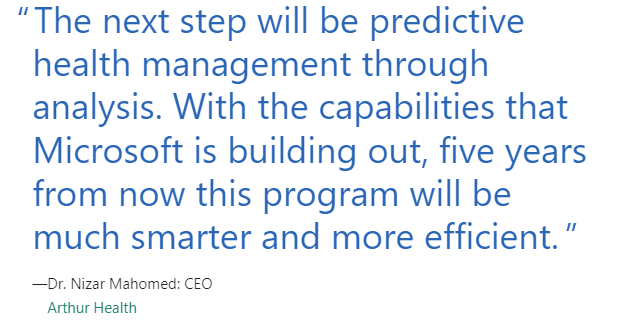Arthur Health’s clinically integrated network solution using Microsoft Power Platform scales pilot program that reduced patient wait times by 80%
Arthur Health, a healthcare solutions company based in Canada, is reimagining traditionally compartmentalized models of care through a clinically integrated network approach. In 2019, Arthur Health teamed up with the Ontario Ministry of Health and Long-Term Care and University Health Network to scale a rapid-access clinic model of care for low-back pain. In a pilot, this led to sustained reduced wait times, better access to local care, and higher patient and provider satisfaction, so Arthur Health plans to expand it. Arthur Health used Microsoft partner Quisitive’s MazikCare platform and Microsoft technologies to develop a patient-centered solution that the company hopes will spark changes to primary and specialty care in Canada.
Chronic medical conditions such as low-back pain (LBP) often involve visits to multiple healthcare providers. The resulting care can be uncoordinated, untimely, and costly to both the patient and the payer. In Canada, where patients often endure long wait times for specialist care, these issues can contribute to detrimental patient and system outcomes. Patients in Ontario sometimes wait more than one year for a specialist appointment, only to find that the specialist does not have all the necessary information or is not the right one for their problem.
Three practicing orthopedic surgeons founded Arthur Health in 2017 with the goal of solving this and other healthcare problems using a clinically integrated network approach supported by digital health technology. They aspired not only to coordinate care but also to deliver clinical and health management best practices across diverse geographies and healthcare settings.
“Effectively managing chronic musculoskeletal pain requires a village,” says Dr. Raja Rampersaud, Chief Medical Officer at Arthur Health. The existing specialty care model did not facilitate good patient outcomes, and the three principals of Arthur Health realized that it was not helping people get the care they needed. “When a patient requires multiple providers, it’s about how you provide shared care with the right providers and align those providers around the needs of a patient,” says Dr. Rampersaud.
Launching a cloud-based solution for collaboration and care close to home in less than a year
Ontario is a large province, and Arthur Health knew that empowering patients in rural, northern, and remote communities to receive the right care closer to home would require a robust digital healthcare solution. To create an integrated, cloud-based healthcare network that houses and shares information, Arthur Health needed technology that was user-friendly, flexible, and scalable. “We needed to choose a solution that was extensible, agile, and provides the highest level of security for handling patient information, so that was the attraction to Microsoft,” says Dr. Christian Veillette, Chief Technology Officer of Arthur Health.
As Arthur Health began exploring solutions to evolve a clinically integrated network, it was introduced to Microsoft partner Quisitive, a company with extensive experience in both Microsoft cloud solutions and the healthcare industry. “We approached Microsoft with our vision, and it directed us to Quisitive,” says Dr. Nizar Mahomed, CEO of Arthur Health. “The company’s depth of understanding of the Microsoft universe and of healthcare complexities would allow us to achieve our vision of an evolving model of care and care delivery, and its MazikCare platform allowed us to innovate faster.”
The Arthur Health team moved quickly to enhance its digital health platform. It drew on Quisitive’s experience to develop a care-coordination platform based on Microsoft Power Platform and Quisitive’s MazikCare in only nine months. The team configured standardized complex-care assessments for providers in the network as well as customized workflows. Communication among medical providers all over Ontario is a central piece of the new system, and Arthur Health created this critical element using the communication and automation capabilities of Microsoft Dynamics 365. “At the end of the day, you need a process to integrate care because the providers are geographically dispersed,” says Dr. Rampersaud.
Arthur Health then began work on the final puzzle piece: an e-referral service that would allow medical providers to quickly send patient referrals and information. It typically takes about one year to develop and deploy an e-referral service in the Canadian healthcare system, but Arthur Health activated its service in only three months, in part through using the security frameworks in Microsoft solutions, fast healthcare interoperability resources, and MazikCare MedicConnect.
Scaling a pilot program that reduced patient wait times by 80 percent to serve more than 10 million adults
The rapid-access clinic model of care was adapted from the successful pilot that ran for five years in metropolitan, urban, and rural and northern healthcare settings. Using an interprofessional shared care model for LBP management that linked primary to tertiary care, the pilot demonstrated immediate improvement in access to care. The average wait time for participants to have a specialized LBP assessment and individualized management plan plummeted from between six and 12 months to two to four weeks—a decrease often of around 80 percent. Many people who would previously have waited in pain and with reduced mobility to see a specialist instead found care closer to home with a physiotherapist or chiropractor supported by a regional centralized specialist. Patients gained unparalleled access to specialized care and payers realized immediate cost savings from a reduction in unnecessary tests such as MRI scans.
The Ontario Ministry of Health and Long-Term Care (MOHLTC) approved expanding the pilot to serve the provincial population of more than 10 million adults. Arthur Health’s partnership with MOHLTC and University Health Network helped create meaningful change for patients and providers through the company’s growing clinically integrated network digital platform. “At scale, satisfaction rates for both patients and physicians have remained greater than 90 percent, according to our surveys,” says Dr. Rampersaud. “The provincial program has happier patients and happier providers, and it has significantly reduced unnecessary MRIs, emergency visits, and specialist referrals to deliver a return on the investment from the Ontario Ministry of Health.”
Supporting more than 8,000 primary care providers with a clinically integrated network
Arthur Health is excited by the potential for further growth and is eager to expand its clinically integrated network platform beyond specialty care. More than 8,000 primary care providers are using this program to refer patients throughout Ontario, demonstrating that patient-centered care delivers better outcomes closer to home. Dr. Veillette sees the next step as incorporating more features of Dynamics 365 to help providers communicate seamlessly and close the circle of care around individual patients. The physicians at Arthur Health are also excited to explore using predictive models as Microsoft further develops its AI capabilities.
“The next step will be predictive health management through analysis,” says Dr. Mahomed. “With the capabilities that Microsoft is building out, five years from now this program will be much smarter and more efficient.”







